Technology's Influence on Consumer Decisions in Travel Sector
VerifiedAdded on 2024/05/30
|31
|6317
|237
Report
AI Summary
This report investigates the influence of technology, specifically social media, on the travel and tourism sector. It explores how social media impacts consumer decision-making processes, facilitates better choices, and affects sales revenue for tour operators. The research outlines the aims, objectives, rationale, and key research questions related to understanding consumer perception and behavior in the context of online travel resources. It critically reviews existing literature, specifies the research philosophy, design, and approach, and includes data collection and analysis. The report further discusses research evaluation techniques, interprets the results, provides recommendations, and suggests areas for further consideration, ultimately presenting the research outcomes in an accessible format. Desklib provides access to this and other solved assignments for students.
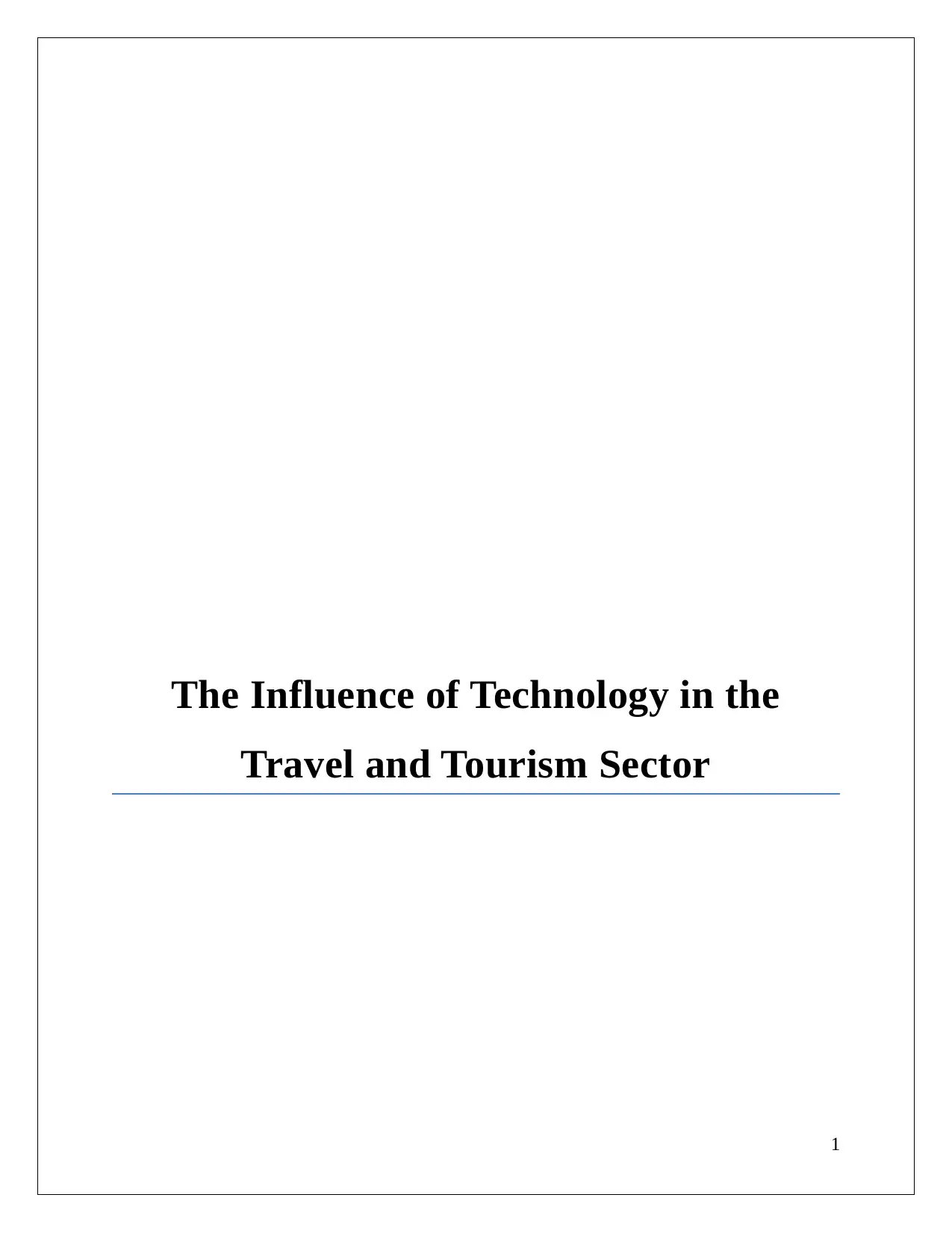
The Influence of Technology in the
Travel and Tourism Sector
1
Travel and Tourism Sector
1
Paraphrase This Document
Need a fresh take? Get an instant paraphrase of this document with our AI Paraphraser
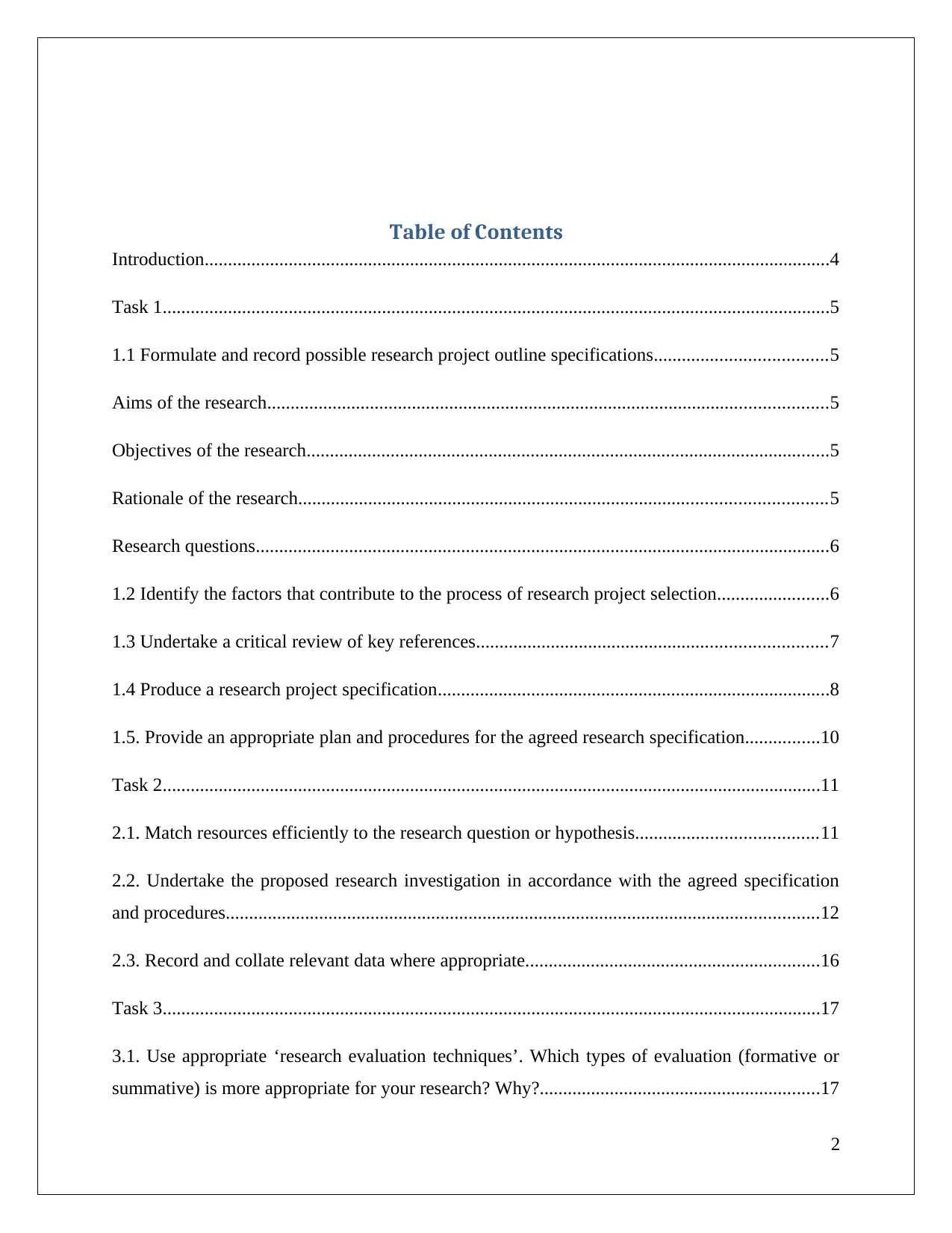
Table of Contents
Introduction......................................................................................................................................4
Task 1...............................................................................................................................................5
1.1 Formulate and record possible research project outline specifications.....................................5
Aims of the research........................................................................................................................5
Objectives of the research................................................................................................................5
Rationale of the research.................................................................................................................5
Research questions...........................................................................................................................6
1.2 Identify the factors that contribute to the process of research project selection........................6
1.3 Undertake a critical review of key references...........................................................................7
1.4 Produce a research project specification....................................................................................8
1.5. Provide an appropriate plan and procedures for the agreed research specification................10
Task 2.............................................................................................................................................11
2.1. Match resources efficiently to the research question or hypothesis.......................................11
2.2. Undertake the proposed research investigation in accordance with the agreed specification
and procedures...............................................................................................................................12
2.3. Record and collate relevant data where appropriate...............................................................16
Task 3.............................................................................................................................................17
3.1. Use appropriate ‘research evaluation techniques’. Which types of evaluation (formative or
summative) is more appropriate for your research? Why?............................................................17
2
Introduction......................................................................................................................................4
Task 1...............................................................................................................................................5
1.1 Formulate and record possible research project outline specifications.....................................5
Aims of the research........................................................................................................................5
Objectives of the research................................................................................................................5
Rationale of the research.................................................................................................................5
Research questions...........................................................................................................................6
1.2 Identify the factors that contribute to the process of research project selection........................6
1.3 Undertake a critical review of key references...........................................................................7
1.4 Produce a research project specification....................................................................................8
1.5. Provide an appropriate plan and procedures for the agreed research specification................10
Task 2.............................................................................................................................................11
2.1. Match resources efficiently to the research question or hypothesis.......................................11
2.2. Undertake the proposed research investigation in accordance with the agreed specification
and procedures...............................................................................................................................12
2.3. Record and collate relevant data where appropriate...............................................................16
Task 3.............................................................................................................................................17
3.1. Use appropriate ‘research evaluation techniques’. Which types of evaluation (formative or
summative) is more appropriate for your research? Why?............................................................17
2
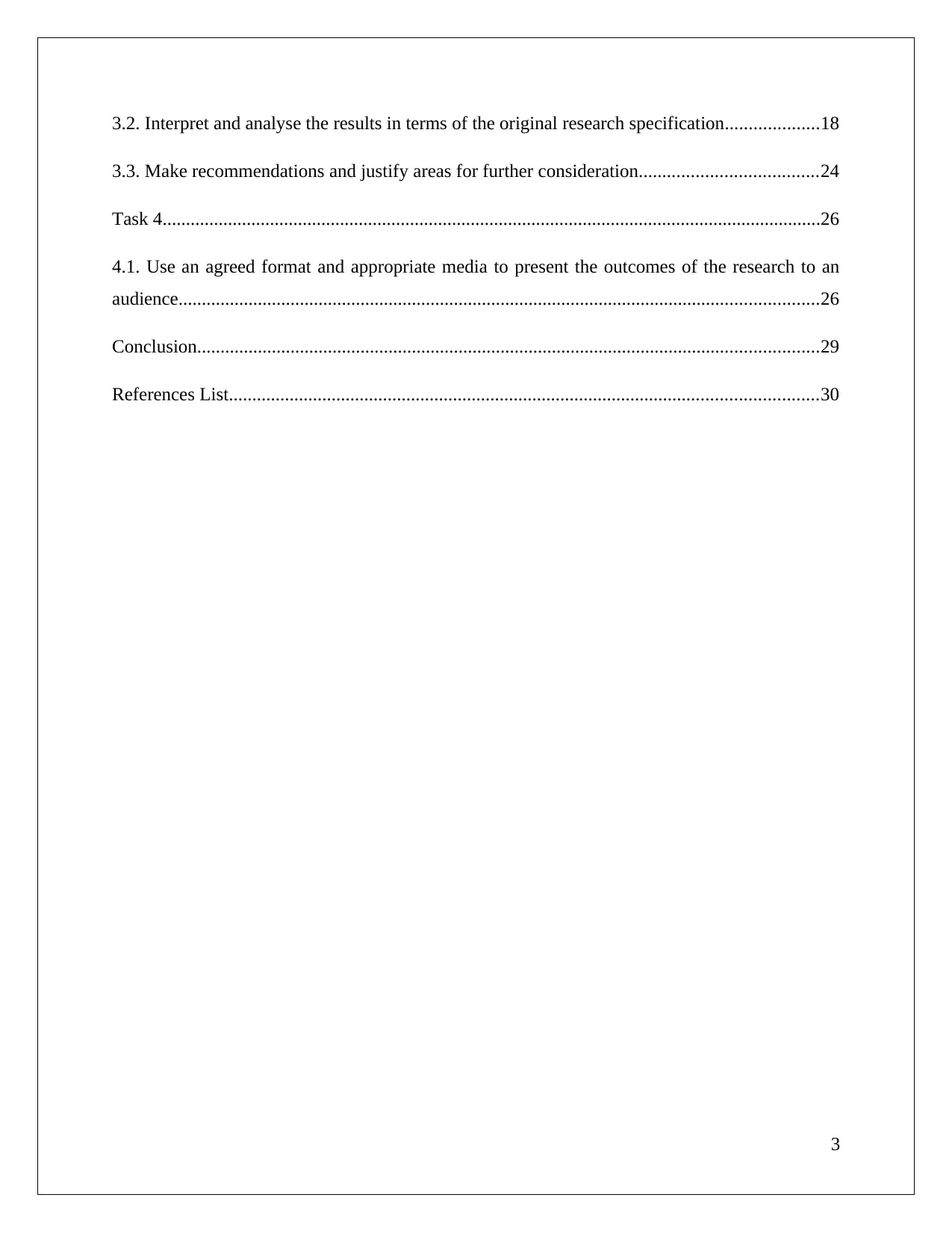
3.2. Interpret and analyse the results in terms of the original research specification....................18
3.3. Make recommendations and justify areas for further consideration......................................24
Task 4.............................................................................................................................................26
4.1. Use an agreed format and appropriate media to present the outcomes of the research to an
audience.........................................................................................................................................26
Conclusion.....................................................................................................................................29
References List..............................................................................................................................30
3
3.3. Make recommendations and justify areas for further consideration......................................24
Task 4.............................................................................................................................................26
4.1. Use an agreed format and appropriate media to present the outcomes of the research to an
audience.........................................................................................................................................26
Conclusion.....................................................................................................................................29
References List..............................................................................................................................30
3
⊘ This is a preview!⊘
Do you want full access?
Subscribe today to unlock all pages.

Trusted by 1+ million students worldwide
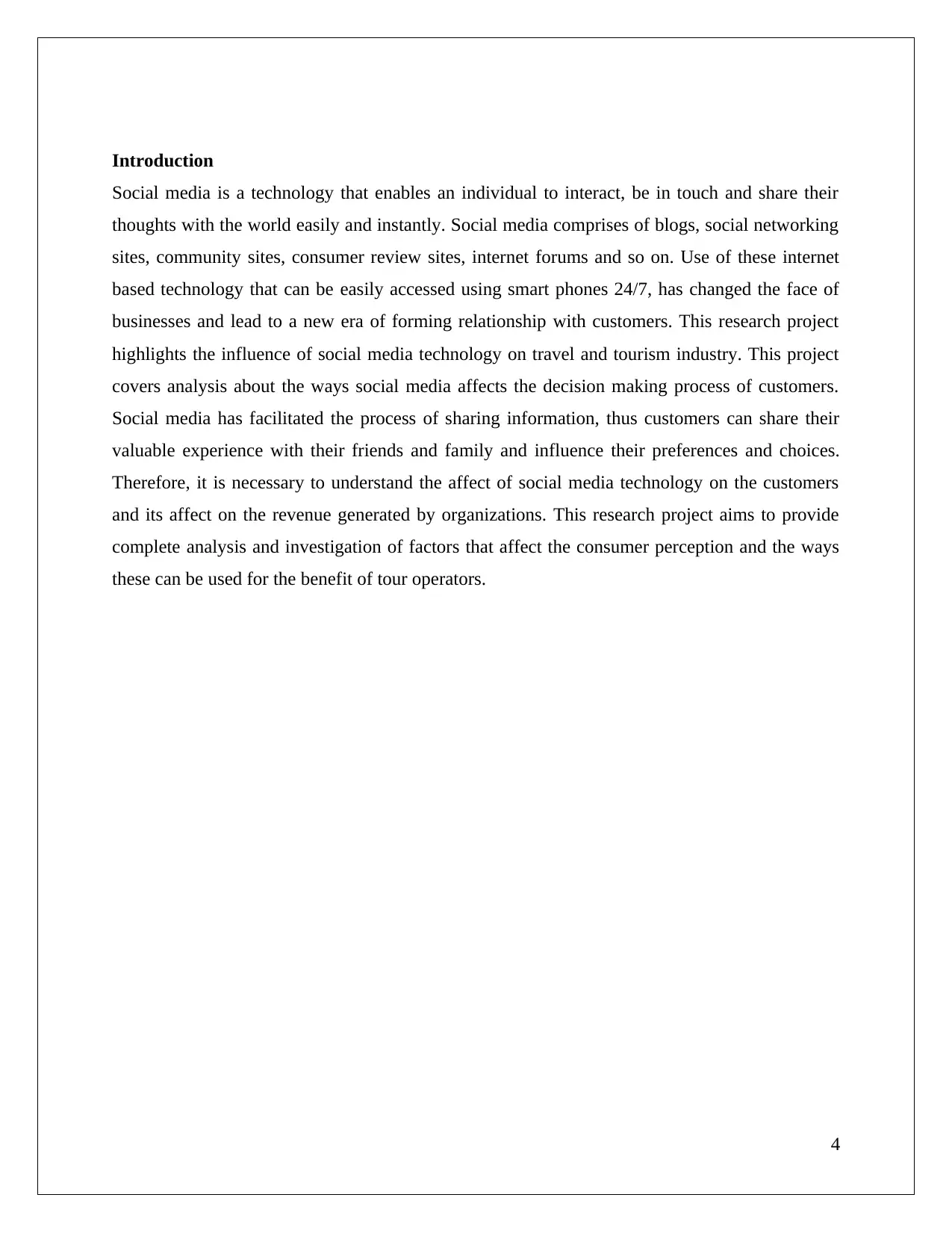
Introduction
Social media is a technology that enables an individual to interact, be in touch and share their
thoughts with the world easily and instantly. Social media comprises of blogs, social networking
sites, community sites, consumer review sites, internet forums and so on. Use of these internet
based technology that can be easily accessed using smart phones 24/7, has changed the face of
businesses and lead to a new era of forming relationship with customers. This research project
highlights the influence of social media technology on travel and tourism industry. This project
covers analysis about the ways social media affects the decision making process of customers.
Social media has facilitated the process of sharing information, thus customers can share their
valuable experience with their friends and family and influence their preferences and choices.
Therefore, it is necessary to understand the affect of social media technology on the customers
and its affect on the revenue generated by organizations. This research project aims to provide
complete analysis and investigation of factors that affect the consumer perception and the ways
these can be used for the benefit of tour operators.
4
Social media is a technology that enables an individual to interact, be in touch and share their
thoughts with the world easily and instantly. Social media comprises of blogs, social networking
sites, community sites, consumer review sites, internet forums and so on. Use of these internet
based technology that can be easily accessed using smart phones 24/7, has changed the face of
businesses and lead to a new era of forming relationship with customers. This research project
highlights the influence of social media technology on travel and tourism industry. This project
covers analysis about the ways social media affects the decision making process of customers.
Social media has facilitated the process of sharing information, thus customers can share their
valuable experience with their friends and family and influence their preferences and choices.
Therefore, it is necessary to understand the affect of social media technology on the customers
and its affect on the revenue generated by organizations. This research project aims to provide
complete analysis and investigation of factors that affect the consumer perception and the ways
these can be used for the benefit of tour operators.
4
Paraphrase This Document
Need a fresh take? Get an instant paraphrase of this document with our AI Paraphraser
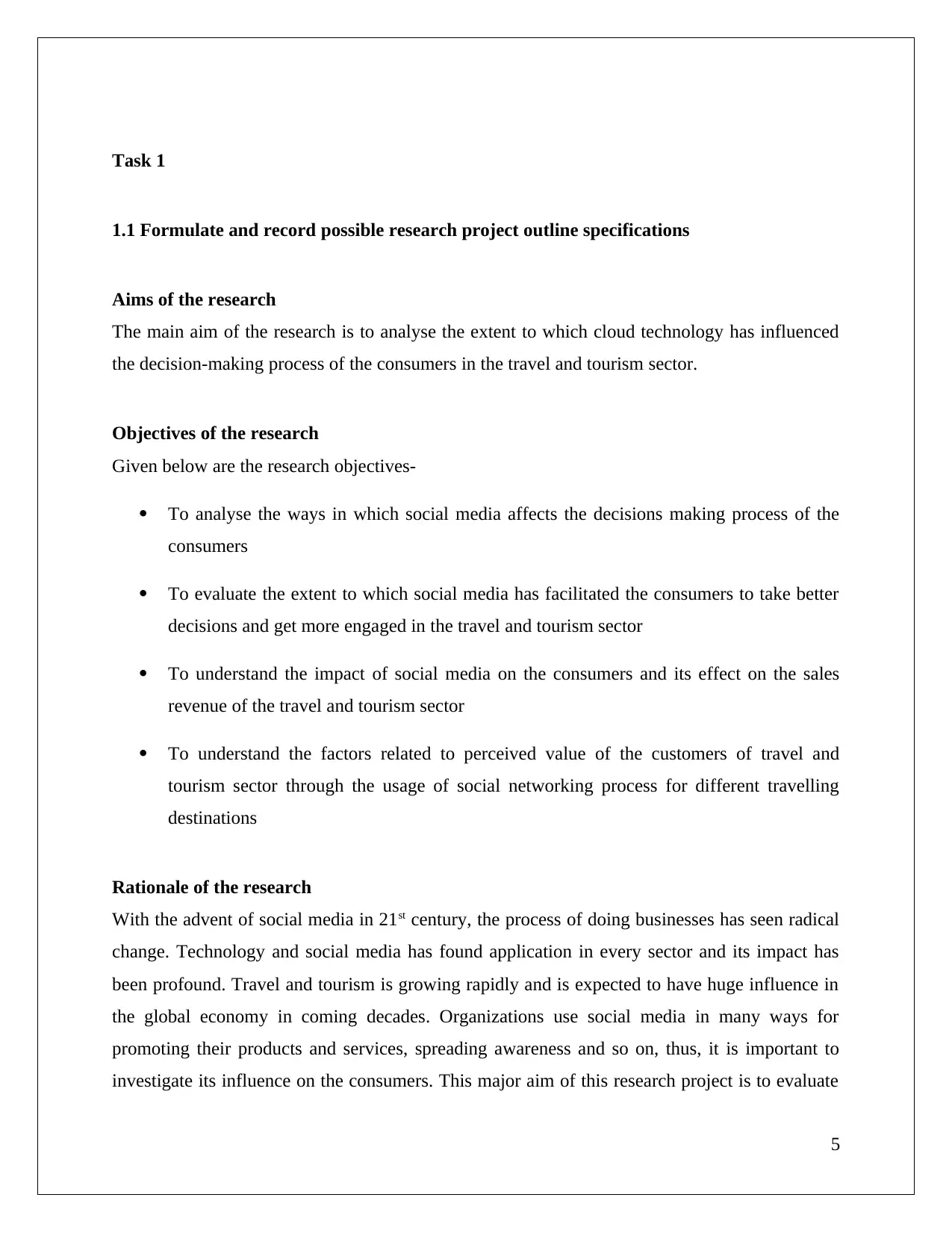
Task 1
1.1 Formulate and record possible research project outline specifications
Aims of the research
The main aim of the research is to analyse the extent to which cloud technology has influenced
the decision-making process of the consumers in the travel and tourism sector.
Objectives of the research
Given below are the research objectives-
To analyse the ways in which social media affects the decisions making process of the
consumers
To evaluate the extent to which social media has facilitated the consumers to take better
decisions and get more engaged in the travel and tourism sector
To understand the impact of social media on the consumers and its effect on the sales
revenue of the travel and tourism sector
To understand the factors related to perceived value of the customers of travel and
tourism sector through the usage of social networking process for different travelling
destinations
Rationale of the research
With the advent of social media in 21st century, the process of doing businesses has seen radical
change. Technology and social media has found application in every sector and its impact has
been profound. Travel and tourism is growing rapidly and is expected to have huge influence in
the global economy in coming decades. Organizations use social media in many ways for
promoting their products and services, spreading awareness and so on, thus, it is important to
investigate its influence on the consumers. This major aim of this research project is to evaluate
5
1.1 Formulate and record possible research project outline specifications
Aims of the research
The main aim of the research is to analyse the extent to which cloud technology has influenced
the decision-making process of the consumers in the travel and tourism sector.
Objectives of the research
Given below are the research objectives-
To analyse the ways in which social media affects the decisions making process of the
consumers
To evaluate the extent to which social media has facilitated the consumers to take better
decisions and get more engaged in the travel and tourism sector
To understand the impact of social media on the consumers and its effect on the sales
revenue of the travel and tourism sector
To understand the factors related to perceived value of the customers of travel and
tourism sector through the usage of social networking process for different travelling
destinations
Rationale of the research
With the advent of social media in 21st century, the process of doing businesses has seen radical
change. Technology and social media has found application in every sector and its impact has
been profound. Travel and tourism is growing rapidly and is expected to have huge influence in
the global economy in coming decades. Organizations use social media in many ways for
promoting their products and services, spreading awareness and so on, thus, it is important to
investigate its influence on the consumers. This major aim of this research project is to evaluate
5
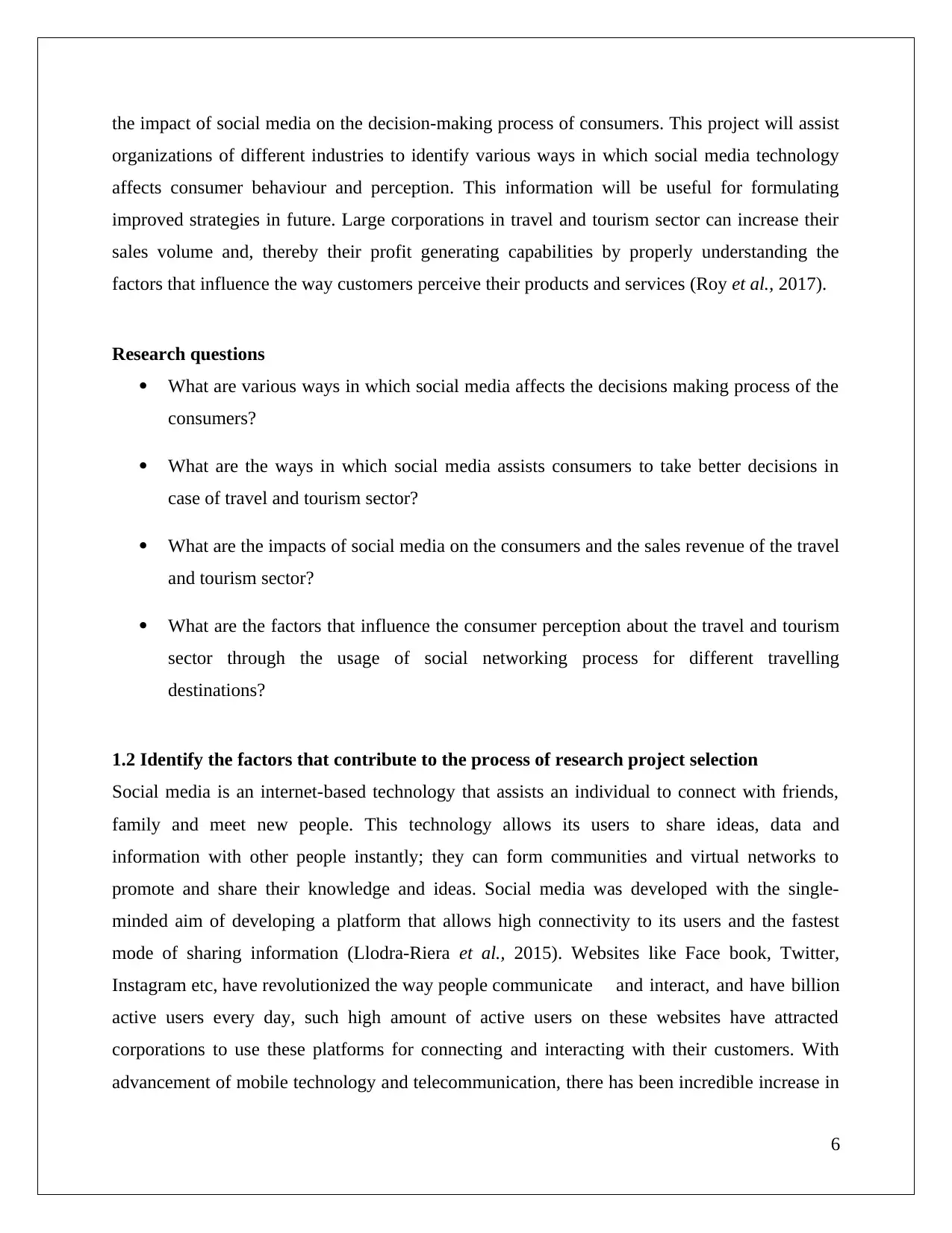
the impact of social media on the decision-making process of consumers. This project will assist
organizations of different industries to identify various ways in which social media technology
affects consumer behaviour and perception. This information will be useful for formulating
improved strategies in future. Large corporations in travel and tourism sector can increase their
sales volume and, thereby their profit generating capabilities by properly understanding the
factors that influence the way customers perceive their products and services (Roy et al., 2017).
Research questions
What are various ways in which social media affects the decisions making process of the
consumers?
What are the ways in which social media assists consumers to take better decisions in
case of travel and tourism sector?
What are the impacts of social media on the consumers and the sales revenue of the travel
and tourism sector?
What are the factors that influence the consumer perception about the travel and tourism
sector through the usage of social networking process for different travelling
destinations?
1.2 Identify the factors that contribute to the process of research project selection
Social media is an internet-based technology that assists an individual to connect with friends,
family and meet new people. This technology allows its users to share ideas, data and
information with other people instantly; they can form communities and virtual networks to
promote and share their knowledge and ideas. Social media was developed with the single-
minded aim of developing a platform that allows high connectivity to its users and the fastest
mode of sharing information (Llodra-Riera et al., 2015). Websites like Face book, Twitter,
Instagram etc, have revolutionized the way people communicate and interact, and have billion
active users every day, such high amount of active users on these websites have attracted
corporations to use these platforms for connecting and interacting with their customers. With
advancement of mobile technology and telecommunication, there has been incredible increase in
6
organizations of different industries to identify various ways in which social media technology
affects consumer behaviour and perception. This information will be useful for formulating
improved strategies in future. Large corporations in travel and tourism sector can increase their
sales volume and, thereby their profit generating capabilities by properly understanding the
factors that influence the way customers perceive their products and services (Roy et al., 2017).
Research questions
What are various ways in which social media affects the decisions making process of the
consumers?
What are the ways in which social media assists consumers to take better decisions in
case of travel and tourism sector?
What are the impacts of social media on the consumers and the sales revenue of the travel
and tourism sector?
What are the factors that influence the consumer perception about the travel and tourism
sector through the usage of social networking process for different travelling
destinations?
1.2 Identify the factors that contribute to the process of research project selection
Social media is an internet-based technology that assists an individual to connect with friends,
family and meet new people. This technology allows its users to share ideas, data and
information with other people instantly; they can form communities and virtual networks to
promote and share their knowledge and ideas. Social media was developed with the single-
minded aim of developing a platform that allows high connectivity to its users and the fastest
mode of sharing information (Llodra-Riera et al., 2015). Websites like Face book, Twitter,
Instagram etc, have revolutionized the way people communicate and interact, and have billion
active users every day, such high amount of active users on these websites have attracted
corporations to use these platforms for connecting and interacting with their customers. With
advancement of mobile technology and telecommunication, there has been incredible increase in
6
⊘ This is a preview!⊘
Do you want full access?
Subscribe today to unlock all pages.

Trusted by 1+ million students worldwide
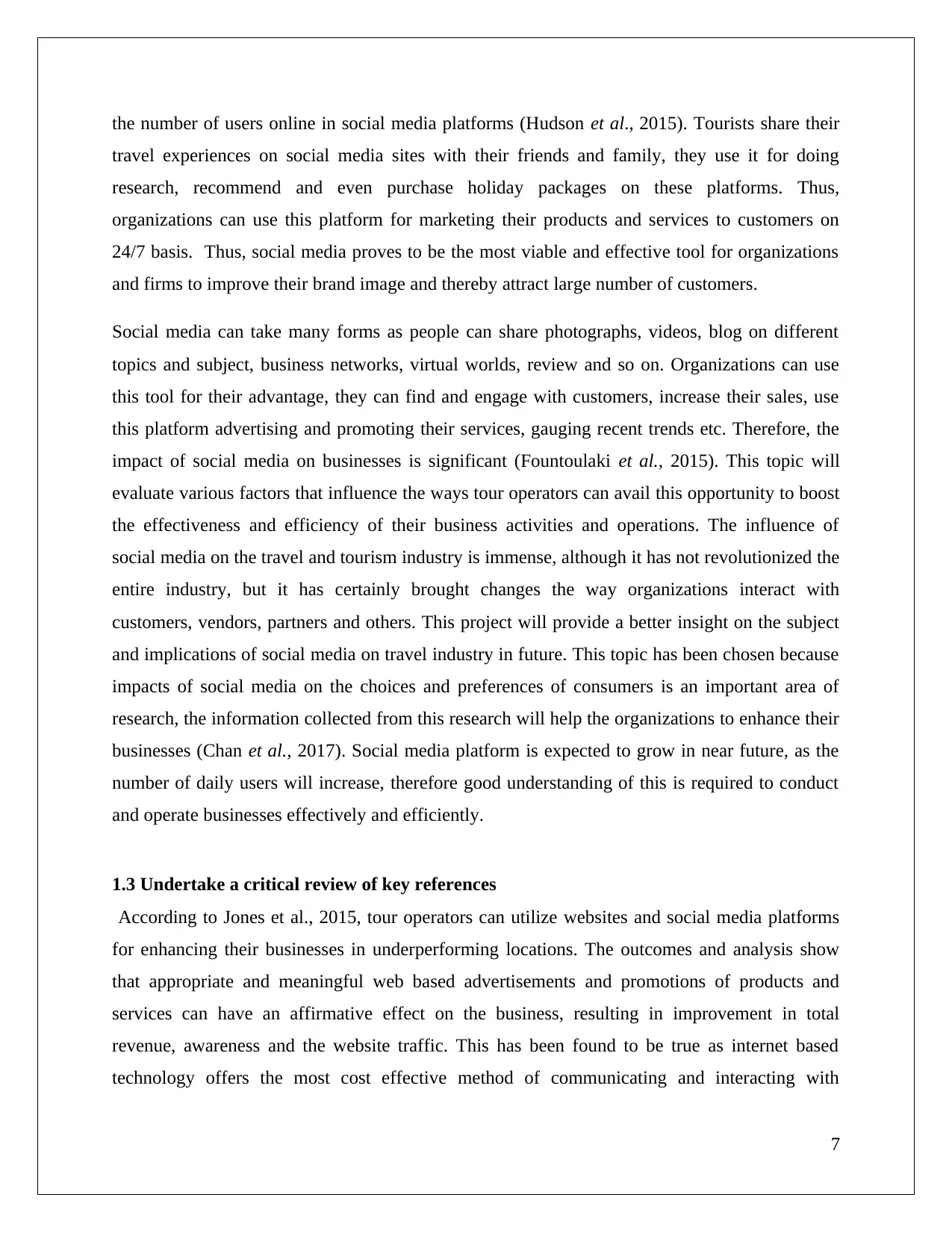
the number of users online in social media platforms (Hudson et al., 2015). Tourists share their
travel experiences on social media sites with their friends and family, they use it for doing
research, recommend and even purchase holiday packages on these platforms. Thus,
organizations can use this platform for marketing their products and services to customers on
24/7 basis. Thus, social media proves to be the most viable and effective tool for organizations
and firms to improve their brand image and thereby attract large number of customers.
Social media can take many forms as people can share photographs, videos, blog on different
topics and subject, business networks, virtual worlds, review and so on. Organizations can use
this tool for their advantage, they can find and engage with customers, increase their sales, use
this platform advertising and promoting their services, gauging recent trends etc. Therefore, the
impact of social media on businesses is significant (Fountoulaki et al., 2015). This topic will
evaluate various factors that influence the ways tour operators can avail this opportunity to boost
the effectiveness and efficiency of their business activities and operations. The influence of
social media on the travel and tourism industry is immense, although it has not revolutionized the
entire industry, but it has certainly brought changes the way organizations interact with
customers, vendors, partners and others. This project will provide a better insight on the subject
and implications of social media on travel industry in future. This topic has been chosen because
impacts of social media on the choices and preferences of consumers is an important area of
research, the information collected from this research will help the organizations to enhance their
businesses (Chan et al., 2017). Social media platform is expected to grow in near future, as the
number of daily users will increase, therefore good understanding of this is required to conduct
and operate businesses effectively and efficiently.
1.3 Undertake a critical review of key references
According to Jones et al., 2015, tour operators can utilize websites and social media platforms
for enhancing their businesses in underperforming locations. The outcomes and analysis show
that appropriate and meaningful web based advertisements and promotions of products and
services can have an affirmative effect on the business, resulting in improvement in total
revenue, awareness and the website traffic. This has been found to be true as internet based
technology offers the most cost effective method of communicating and interacting with
7
travel experiences on social media sites with their friends and family, they use it for doing
research, recommend and even purchase holiday packages on these platforms. Thus,
organizations can use this platform for marketing their products and services to customers on
24/7 basis. Thus, social media proves to be the most viable and effective tool for organizations
and firms to improve their brand image and thereby attract large number of customers.
Social media can take many forms as people can share photographs, videos, blog on different
topics and subject, business networks, virtual worlds, review and so on. Organizations can use
this tool for their advantage, they can find and engage with customers, increase their sales, use
this platform advertising and promoting their services, gauging recent trends etc. Therefore, the
impact of social media on businesses is significant (Fountoulaki et al., 2015). This topic will
evaluate various factors that influence the ways tour operators can avail this opportunity to boost
the effectiveness and efficiency of their business activities and operations. The influence of
social media on the travel and tourism industry is immense, although it has not revolutionized the
entire industry, but it has certainly brought changes the way organizations interact with
customers, vendors, partners and others. This project will provide a better insight on the subject
and implications of social media on travel industry in future. This topic has been chosen because
impacts of social media on the choices and preferences of consumers is an important area of
research, the information collected from this research will help the organizations to enhance their
businesses (Chan et al., 2017). Social media platform is expected to grow in near future, as the
number of daily users will increase, therefore good understanding of this is required to conduct
and operate businesses effectively and efficiently.
1.3 Undertake a critical review of key references
According to Jones et al., 2015, tour operators can utilize websites and social media platforms
for enhancing their businesses in underperforming locations. The outcomes and analysis show
that appropriate and meaningful web based advertisements and promotions of products and
services can have an affirmative effect on the business, resulting in improvement in total
revenue, awareness and the website traffic. This has been found to be true as internet based
technology offers the most cost effective method of communicating and interacting with
7
Paraphrase This Document
Need a fresh take? Get an instant paraphrase of this document with our AI Paraphraser
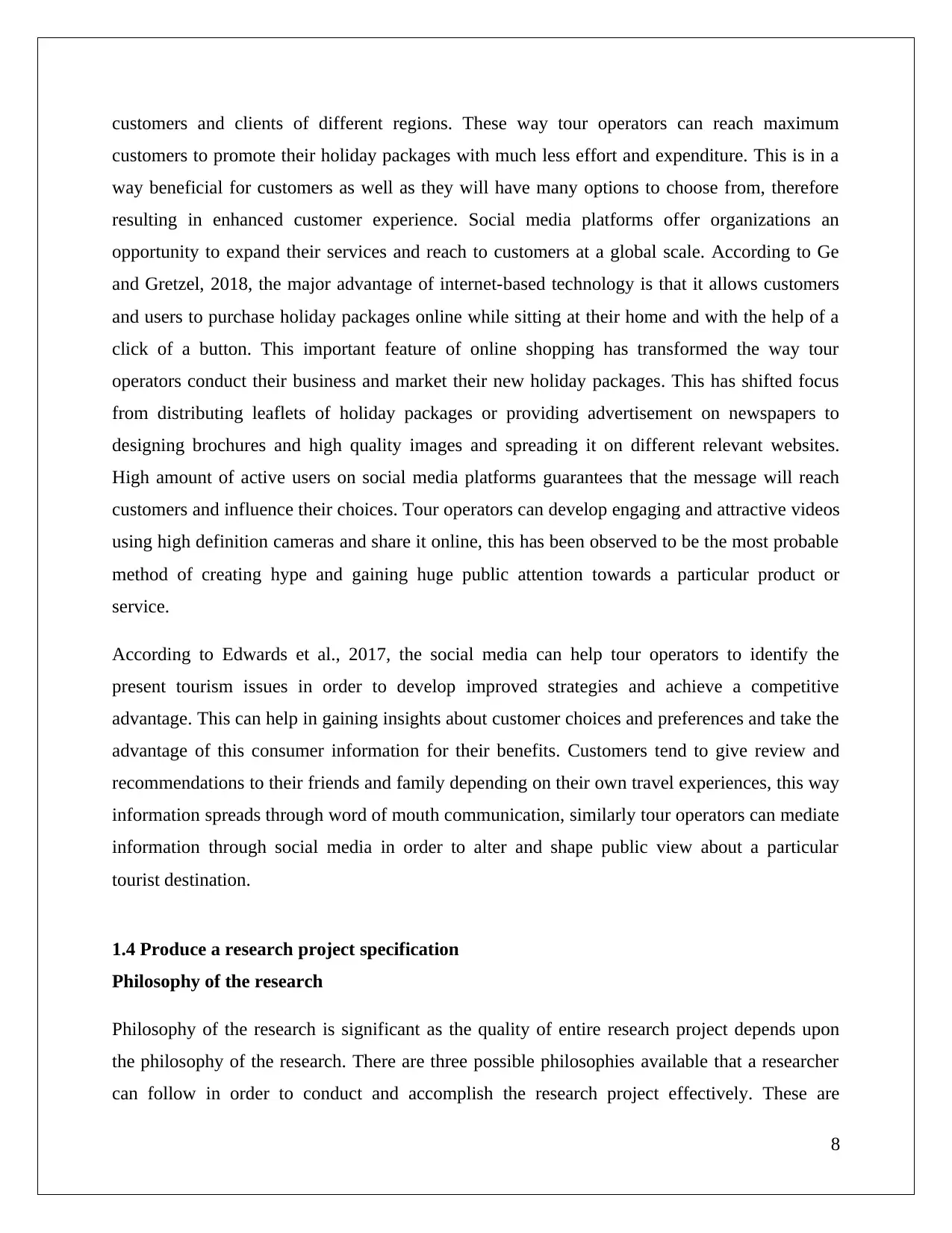
customers and clients of different regions. These way tour operators can reach maximum
customers to promote their holiday packages with much less effort and expenditure. This is in a
way beneficial for customers as well as they will have many options to choose from, therefore
resulting in enhanced customer experience. Social media platforms offer organizations an
opportunity to expand their services and reach to customers at a global scale. According to Ge
and Gretzel, 2018, the major advantage of internet-based technology is that it allows customers
and users to purchase holiday packages online while sitting at their home and with the help of a
click of a button. This important feature of online shopping has transformed the way tour
operators conduct their business and market their new holiday packages. This has shifted focus
from distributing leaflets of holiday packages or providing advertisement on newspapers to
designing brochures and high quality images and spreading it on different relevant websites.
High amount of active users on social media platforms guarantees that the message will reach
customers and influence their choices. Tour operators can develop engaging and attractive videos
using high definition cameras and share it online, this has been observed to be the most probable
method of creating hype and gaining huge public attention towards a particular product or
service.
According to Edwards et al., 2017, the social media can help tour operators to identify the
present tourism issues in order to develop improved strategies and achieve a competitive
advantage. This can help in gaining insights about customer choices and preferences and take the
advantage of this consumer information for their benefits. Customers tend to give review and
recommendations to their friends and family depending on their own travel experiences, this way
information spreads through word of mouth communication, similarly tour operators can mediate
information through social media in order to alter and shape public view about a particular
tourist destination.
1.4 Produce a research project specification
Philosophy of the research
Philosophy of the research is significant as the quality of entire research project depends upon
the philosophy of the research. There are three possible philosophies available that a researcher
can follow in order to conduct and accomplish the research project effectively. These are
8
customers to promote their holiday packages with much less effort and expenditure. This is in a
way beneficial for customers as well as they will have many options to choose from, therefore
resulting in enhanced customer experience. Social media platforms offer organizations an
opportunity to expand their services and reach to customers at a global scale. According to Ge
and Gretzel, 2018, the major advantage of internet-based technology is that it allows customers
and users to purchase holiday packages online while sitting at their home and with the help of a
click of a button. This important feature of online shopping has transformed the way tour
operators conduct their business and market their new holiday packages. This has shifted focus
from distributing leaflets of holiday packages or providing advertisement on newspapers to
designing brochures and high quality images and spreading it on different relevant websites.
High amount of active users on social media platforms guarantees that the message will reach
customers and influence their choices. Tour operators can develop engaging and attractive videos
using high definition cameras and share it online, this has been observed to be the most probable
method of creating hype and gaining huge public attention towards a particular product or
service.
According to Edwards et al., 2017, the social media can help tour operators to identify the
present tourism issues in order to develop improved strategies and achieve a competitive
advantage. This can help in gaining insights about customer choices and preferences and take the
advantage of this consumer information for their benefits. Customers tend to give review and
recommendations to their friends and family depending on their own travel experiences, this way
information spreads through word of mouth communication, similarly tour operators can mediate
information through social media in order to alter and shape public view about a particular
tourist destination.
1.4 Produce a research project specification
Philosophy of the research
Philosophy of the research is significant as the quality of entire research project depends upon
the philosophy of the research. There are three possible philosophies available that a researcher
can follow in order to conduct and accomplish the research project effectively. These are
8
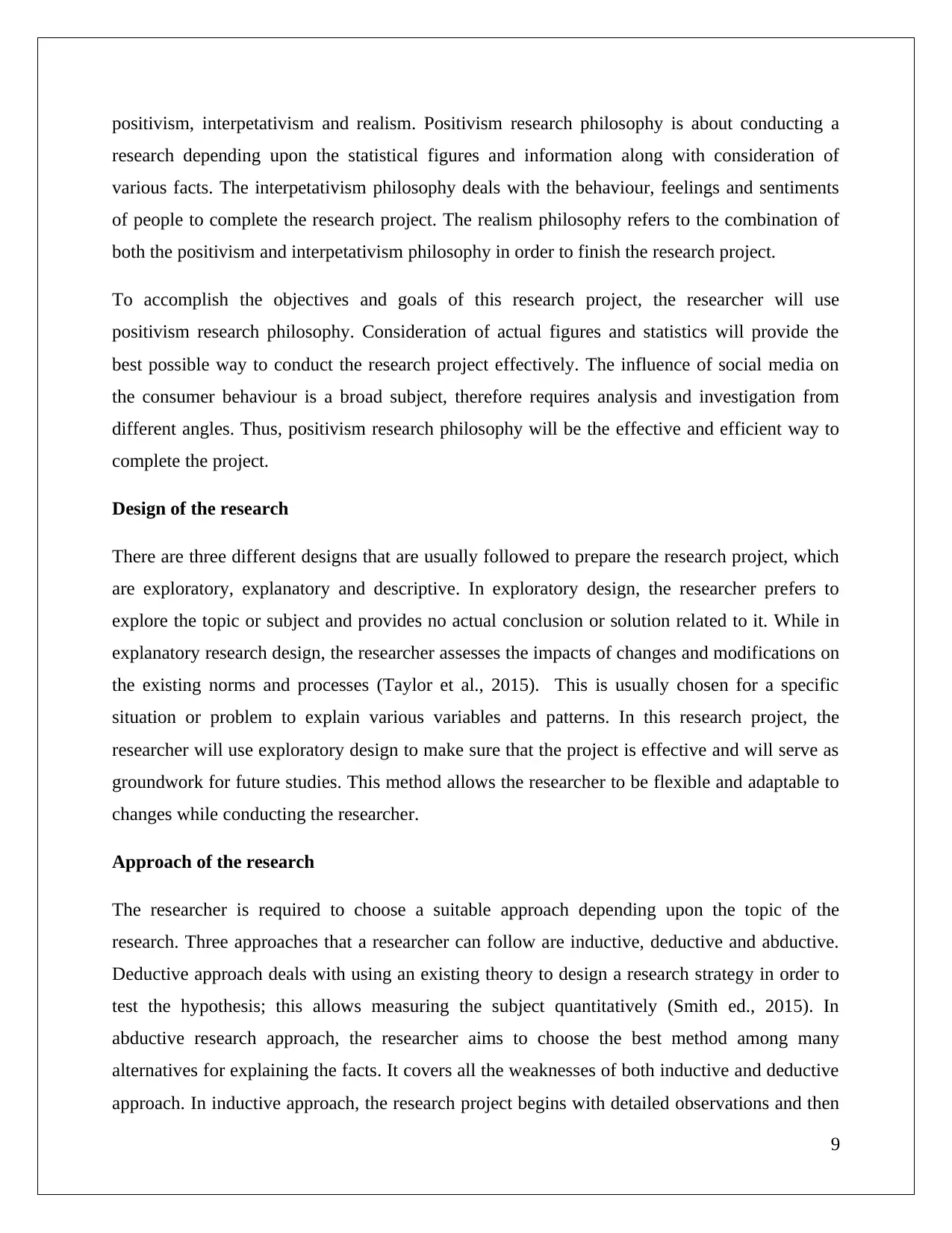
positivism, interpetativism and realism. Positivism research philosophy is about conducting a
research depending upon the statistical figures and information along with consideration of
various facts. The interpetativism philosophy deals with the behaviour, feelings and sentiments
of people to complete the research project. The realism philosophy refers to the combination of
both the positivism and interpetativism philosophy in order to finish the research project.
To accomplish the objectives and goals of this research project, the researcher will use
positivism research philosophy. Consideration of actual figures and statistics will provide the
best possible way to conduct the research project effectively. The influence of social media on
the consumer behaviour is a broad subject, therefore requires analysis and investigation from
different angles. Thus, positivism research philosophy will be the effective and efficient way to
complete the project.
Design of the research
There are three different designs that are usually followed to prepare the research project, which
are exploratory, explanatory and descriptive. In exploratory design, the researcher prefers to
explore the topic or subject and provides no actual conclusion or solution related to it. While in
explanatory research design, the researcher assesses the impacts of changes and modifications on
the existing norms and processes (Taylor et al., 2015). This is usually chosen for a specific
situation or problem to explain various variables and patterns. In this research project, the
researcher will use exploratory design to make sure that the project is effective and will serve as
groundwork for future studies. This method allows the researcher to be flexible and adaptable to
changes while conducting the researcher.
Approach of the research
The researcher is required to choose a suitable approach depending upon the topic of the
research. Three approaches that a researcher can follow are inductive, deductive and abductive.
Deductive approach deals with using an existing theory to design a research strategy in order to
test the hypothesis; this allows measuring the subject quantitatively (Smith ed., 2015). In
abductive research approach, the researcher aims to choose the best method among many
alternatives for explaining the facts. It covers all the weaknesses of both inductive and deductive
approach. In inductive approach, the research project begins with detailed observations and then
9
research depending upon the statistical figures and information along with consideration of
various facts. The interpetativism philosophy deals with the behaviour, feelings and sentiments
of people to complete the research project. The realism philosophy refers to the combination of
both the positivism and interpetativism philosophy in order to finish the research project.
To accomplish the objectives and goals of this research project, the researcher will use
positivism research philosophy. Consideration of actual figures and statistics will provide the
best possible way to conduct the research project effectively. The influence of social media on
the consumer behaviour is a broad subject, therefore requires analysis and investigation from
different angles. Thus, positivism research philosophy will be the effective and efficient way to
complete the project.
Design of the research
There are three different designs that are usually followed to prepare the research project, which
are exploratory, explanatory and descriptive. In exploratory design, the researcher prefers to
explore the topic or subject and provides no actual conclusion or solution related to it. While in
explanatory research design, the researcher assesses the impacts of changes and modifications on
the existing norms and processes (Taylor et al., 2015). This is usually chosen for a specific
situation or problem to explain various variables and patterns. In this research project, the
researcher will use exploratory design to make sure that the project is effective and will serve as
groundwork for future studies. This method allows the researcher to be flexible and adaptable to
changes while conducting the researcher.
Approach of the research
The researcher is required to choose a suitable approach depending upon the topic of the
research. Three approaches that a researcher can follow are inductive, deductive and abductive.
Deductive approach deals with using an existing theory to design a research strategy in order to
test the hypothesis; this allows measuring the subject quantitatively (Smith ed., 2015). In
abductive research approach, the researcher aims to choose the best method among many
alternatives for explaining the facts. It covers all the weaknesses of both inductive and deductive
approach. In inductive approach, the research project begins with detailed observations and then
9
⊘ This is a preview!⊘
Do you want full access?
Subscribe today to unlock all pages.

Trusted by 1+ million students worldwide
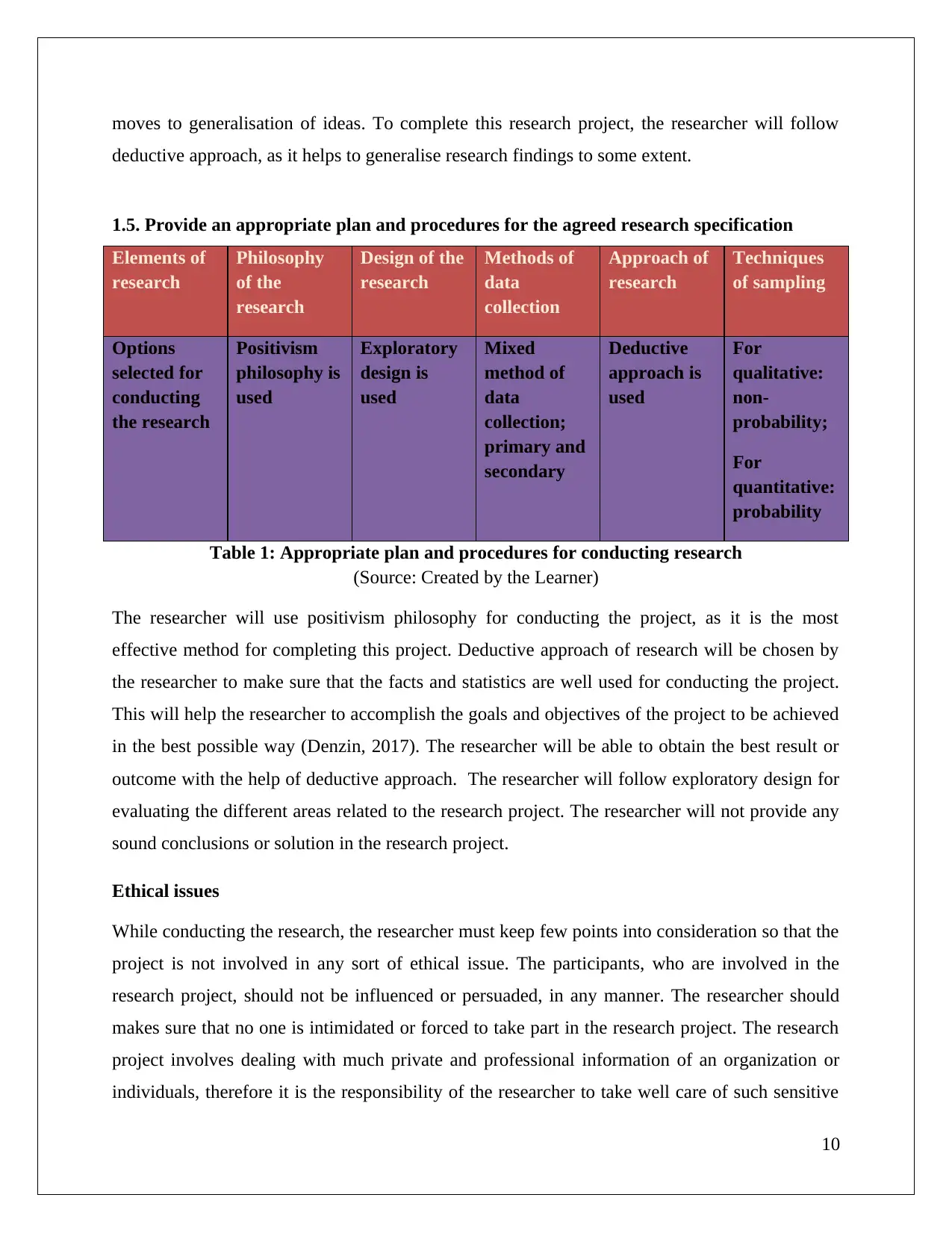
moves to generalisation of ideas. To complete this research project, the researcher will follow
deductive approach, as it helps to generalise research findings to some extent.
1.5. Provide an appropriate plan and procedures for the agreed research specification
Elements of
research
Philosophy
of the
research
Design of the
research
Methods of
data
collection
Approach of
research
Techniques
of sampling
Options
selected for
conducting
the research
Positivism
philosophy is
used
Exploratory
design is
used
Mixed
method of
data
collection;
primary and
secondary
Deductive
approach is
used
For
qualitative:
non-
probability;
For
quantitative:
probability
Table 1: Appropriate plan and procedures for conducting research
(Source: Created by the Learner)
The researcher will use positivism philosophy for conducting the project, as it is the most
effective method for completing this project. Deductive approach of research will be chosen by
the researcher to make sure that the facts and statistics are well used for conducting the project.
This will help the researcher to accomplish the goals and objectives of the project to be achieved
in the best possible way (Denzin, 2017). The researcher will be able to obtain the best result or
outcome with the help of deductive approach. The researcher will follow exploratory design for
evaluating the different areas related to the research project. The researcher will not provide any
sound conclusions or solution in the research project.
Ethical issues
While conducting the research, the researcher must keep few points into consideration so that the
project is not involved in any sort of ethical issue. The participants, who are involved in the
research project, should not be influenced or persuaded, in any manner. The researcher should
makes sure that no one is intimidated or forced to take part in the research project. The research
project involves dealing with much private and professional information of an organization or
individuals, therefore it is the responsibility of the researcher to take well care of such sensitive
10
deductive approach, as it helps to generalise research findings to some extent.
1.5. Provide an appropriate plan and procedures for the agreed research specification
Elements of
research
Philosophy
of the
research
Design of the
research
Methods of
data
collection
Approach of
research
Techniques
of sampling
Options
selected for
conducting
the research
Positivism
philosophy is
used
Exploratory
design is
used
Mixed
method of
data
collection;
primary and
secondary
Deductive
approach is
used
For
qualitative:
non-
probability;
For
quantitative:
probability
Table 1: Appropriate plan and procedures for conducting research
(Source: Created by the Learner)
The researcher will use positivism philosophy for conducting the project, as it is the most
effective method for completing this project. Deductive approach of research will be chosen by
the researcher to make sure that the facts and statistics are well used for conducting the project.
This will help the researcher to accomplish the goals and objectives of the project to be achieved
in the best possible way (Denzin, 2017). The researcher will be able to obtain the best result or
outcome with the help of deductive approach. The researcher will follow exploratory design for
evaluating the different areas related to the research project. The researcher will not provide any
sound conclusions or solution in the research project.
Ethical issues
While conducting the research, the researcher must keep few points into consideration so that the
project is not involved in any sort of ethical issue. The participants, who are involved in the
research project, should not be influenced or persuaded, in any manner. The researcher should
makes sure that no one is intimidated or forced to take part in the research project. The research
project involves dealing with much private and professional information of an organization or
individuals, therefore it is the responsibility of the researcher to take well care of such sensitive
10
Paraphrase This Document
Need a fresh take? Get an instant paraphrase of this document with our AI Paraphraser
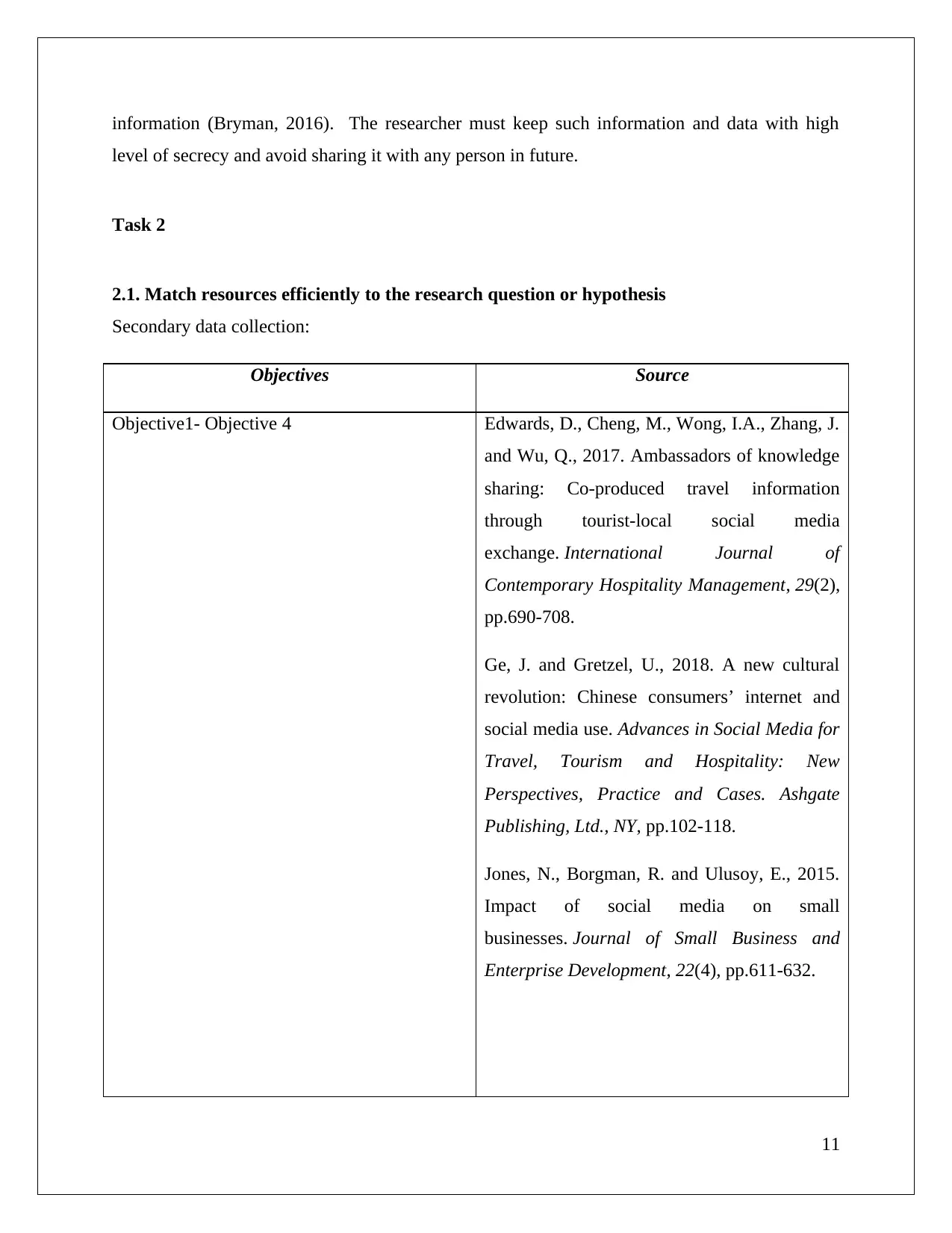
information (Bryman, 2016). The researcher must keep such information and data with high
level of secrecy and avoid sharing it with any person in future.
Task 2
2.1. Match resources efficiently to the research question or hypothesis
Secondary data collection:
Objectives Source
Objective1- Objective 4 Edwards, D., Cheng, M., Wong, I.A., Zhang, J.
and Wu, Q., 2017. Ambassadors of knowledge
sharing: Co-produced travel information
through tourist-local social media
exchange. International Journal of
Contemporary Hospitality Management, 29(2),
pp.690-708.
Ge, J. and Gretzel, U., 2018. A new cultural
revolution: Chinese consumers’ internet and
social media use. Advances in Social Media for
Travel, Tourism and Hospitality: New
Perspectives, Practice and Cases. Ashgate
Publishing, Ltd., NY, pp.102-118.
Jones, N., Borgman, R. and Ulusoy, E., 2015.
Impact of social media on small
businesses. Journal of Small Business and
Enterprise Development, 22(4), pp.611-632.
11
level of secrecy and avoid sharing it with any person in future.
Task 2
2.1. Match resources efficiently to the research question or hypothesis
Secondary data collection:
Objectives Source
Objective1- Objective 4 Edwards, D., Cheng, M., Wong, I.A., Zhang, J.
and Wu, Q., 2017. Ambassadors of knowledge
sharing: Co-produced travel information
through tourist-local social media
exchange. International Journal of
Contemporary Hospitality Management, 29(2),
pp.690-708.
Ge, J. and Gretzel, U., 2018. A new cultural
revolution: Chinese consumers’ internet and
social media use. Advances in Social Media for
Travel, Tourism and Hospitality: New
Perspectives, Practice and Cases. Ashgate
Publishing, Ltd., NY, pp.102-118.
Jones, N., Borgman, R. and Ulusoy, E., 2015.
Impact of social media on small
businesses. Journal of Small Business and
Enterprise Development, 22(4), pp.611-632.
11
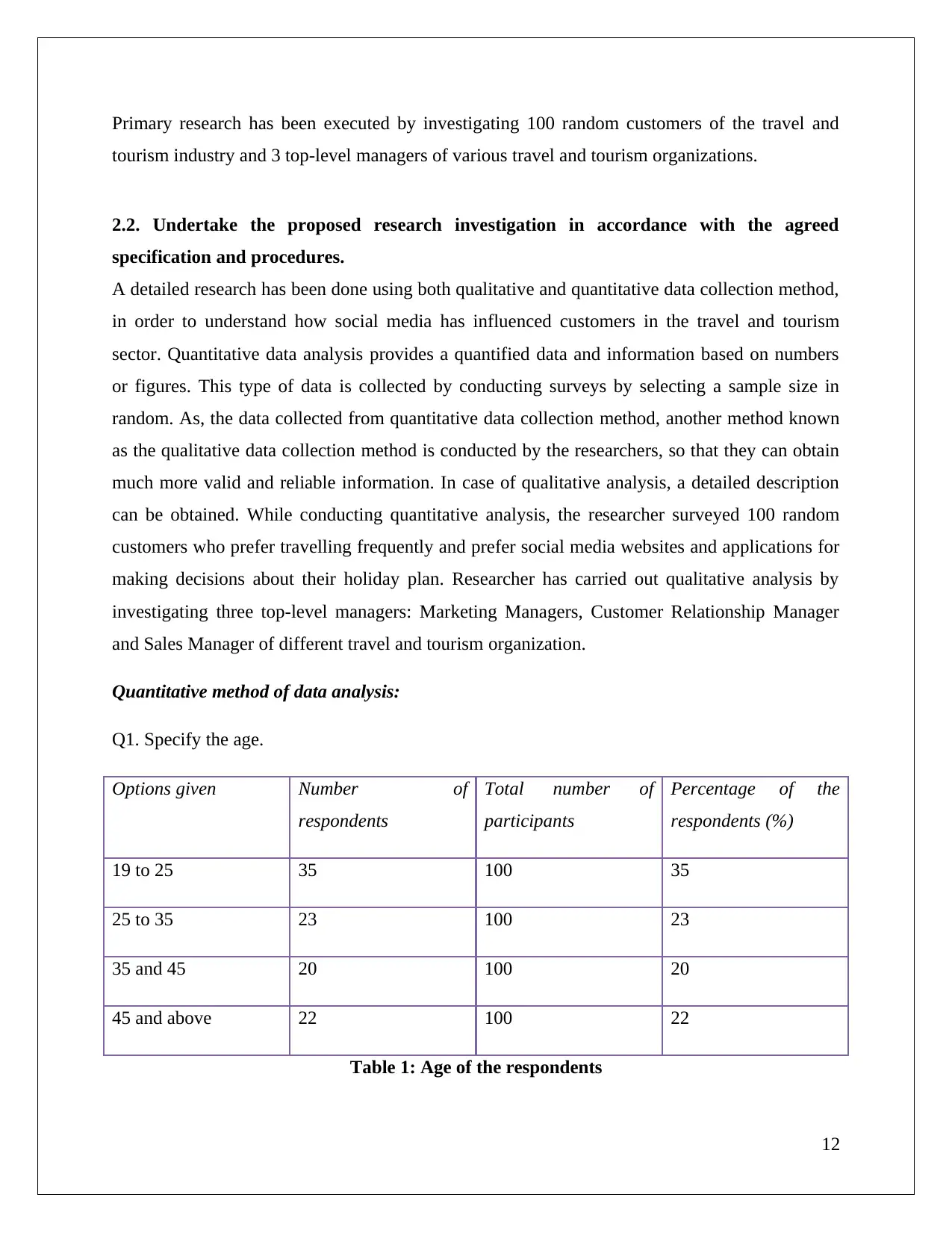
Primary research has been executed by investigating 100 random customers of the travel and
tourism industry and 3 top-level managers of various travel and tourism organizations.
2.2. Undertake the proposed research investigation in accordance with the agreed
specification and procedures.
A detailed research has been done using both qualitative and quantitative data collection method,
in order to understand how social media has influenced customers in the travel and tourism
sector. Quantitative data analysis provides a quantified data and information based on numbers
or figures. This type of data is collected by conducting surveys by selecting a sample size in
random. As, the data collected from quantitative data collection method, another method known
as the qualitative data collection method is conducted by the researchers, so that they can obtain
much more valid and reliable information. In case of qualitative analysis, a detailed description
can be obtained. While conducting quantitative analysis, the researcher surveyed 100 random
customers who prefer travelling frequently and prefer social media websites and applications for
making decisions about their holiday plan. Researcher has carried out qualitative analysis by
investigating three top-level managers: Marketing Managers, Customer Relationship Manager
and Sales Manager of different travel and tourism organization.
Quantitative method of data analysis:
Q1. Specify the age.
Options given Number of
respondents
Total number of
participants
Percentage of the
respondents (%)
19 to 25 35 100 35
25 to 35 23 100 23
35 and 45 20 100 20
45 and above 22 100 22
Table 1: Age of the respondents
12
tourism industry and 3 top-level managers of various travel and tourism organizations.
2.2. Undertake the proposed research investigation in accordance with the agreed
specification and procedures.
A detailed research has been done using both qualitative and quantitative data collection method,
in order to understand how social media has influenced customers in the travel and tourism
sector. Quantitative data analysis provides a quantified data and information based on numbers
or figures. This type of data is collected by conducting surveys by selecting a sample size in
random. As, the data collected from quantitative data collection method, another method known
as the qualitative data collection method is conducted by the researchers, so that they can obtain
much more valid and reliable information. In case of qualitative analysis, a detailed description
can be obtained. While conducting quantitative analysis, the researcher surveyed 100 random
customers who prefer travelling frequently and prefer social media websites and applications for
making decisions about their holiday plan. Researcher has carried out qualitative analysis by
investigating three top-level managers: Marketing Managers, Customer Relationship Manager
and Sales Manager of different travel and tourism organization.
Quantitative method of data analysis:
Q1. Specify the age.
Options given Number of
respondents
Total number of
participants
Percentage of the
respondents (%)
19 to 25 35 100 35
25 to 35 23 100 23
35 and 45 20 100 20
45 and above 22 100 22
Table 1: Age of the respondents
12
⊘ This is a preview!⊘
Do you want full access?
Subscribe today to unlock all pages.

Trusted by 1+ million students worldwide
1 out of 31
Related Documents
Your All-in-One AI-Powered Toolkit for Academic Success.
+13062052269
info@desklib.com
Available 24*7 on WhatsApp / Email
![[object Object]](/_next/static/media/star-bottom.7253800d.svg)
Unlock your academic potential
Copyright © 2020–2025 A2Z Services. All Rights Reserved. Developed and managed by ZUCOL.




